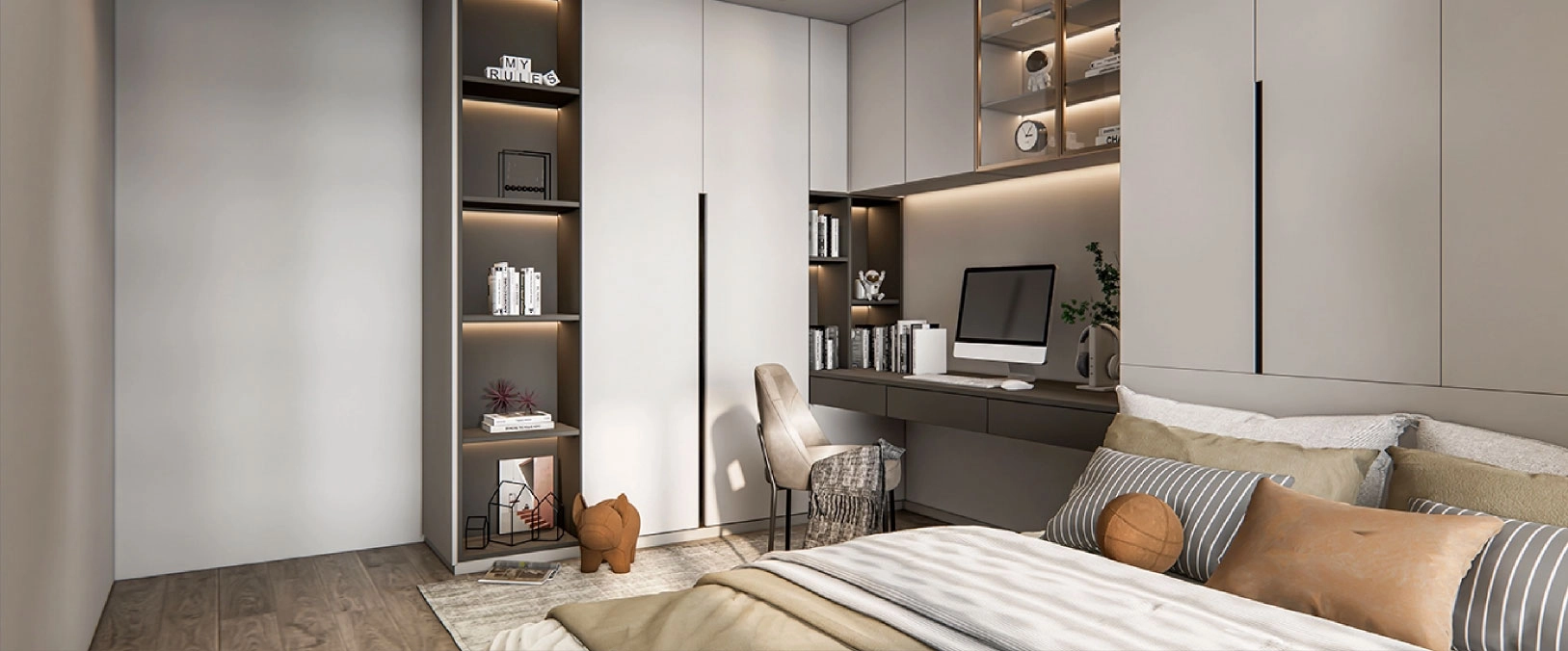Recommendations and advice for planning interiors
Location and Overall Dimensions of the Wardrobe
The first step in creating a wardrobe plan is carefully considering where the wardrobe will be installed and what its dimensions should be. Is it a bedroom closet, a hall closet, or a separate wardrobe? What is its purpose, and what clothes or items will be stored inside? Will drawers or baskets be needed? How many clothes will be hung, and at what height? How much space is available for the wardrobe? Additionally, budget considerations should be taken into account.
The total depth of a wardrobe with doors should be at least 600mm but preferably not more than 800mm to ensure easy access to shelves. Shelves, drawers, and baskets are available in various depths (400mm and 500mm), but the main factor influencing depth is the space required for hanging garments.
If space is limited, we recommend using pull-out clothes hangers, which allow easy access by pulling clothes forward rather than storing them side by side.
Wardrobe Solution and Layout
When designing a shelving system, outline what will be stored inside to determine the required number of shelves, baskets, and hanging rods.
- Shelving – The most cost-effective storage solution, easily replacing baskets and drawers at a lower price.
- Baskets – Ideal for T-shirts, bed linen, towels, and sweaters. Higher baskets work well for bulkier items like blankets and pillows, while lower baskets are suited for smaller items.
- Drawers – Recommended for socks, gloves, scarves, and small clothing items.
Choice of Material for the Wardrobe System
Wardrobe sidewalls, shelves, ceilings, and partitions can be made from 18mm or 28mm melamine board (some materials are also available in 25mm). Generally, 18mm thickness provides sufficient strength and durability, though thicker boards (28mm) may be used for a modern, solid look.
Our material range includes over 15 different melamine finishes, along with a variety of oil wax shades for oak veneer. Customers often select visible cabinet sides and sliding doors in a color matching their interior, while hidden parts (partitions, shelves, and drawers) use a more affordable material (e.g., monochrome white or grey).
We recommend choosing drawers with soft-closing slides, a hallmark of quality in modern wardrobe systems. STIG Interior drawers feature 100% opening and soft-closing slides, ensuring smooth functionality and long-lasting comfort.
Baskets and coat hangers are available in white and silver.
Recommended Internal Dimensions
- Shelf height: 25 – 35cm. Higher spacing wastes space, while lower spacing can be inconvenient for deep shelves.
- Pull-out shelving: Designed to optimize storage by allowing tighter stacking of shelves.
- Maximum shelf length: 100cm (1m). Shelves longer than 120cm should be supported by a vertical tube or partition.
- Hanging garments: Minimum depth of 50cm is required to prevent interference with sliding doors.
- Double-level hanging: Upper rod at 1.9 – 2.0m, lower rod at ~1m from the floor.
- Long garments (coats, dresses): Recommended height of 140 – 160cm.
- Support for long rods: Clothes rails longer than 120cm should have a center support to prevent bending.
Arrangement of Wardrobe Units
When planning baskets, shelving, and drawers, ensure they can slide out properly without obstruction from wardrobe doors. It is advisable to group these elements in the same shelving unit for convenience.
We recommend placing drawers on the sides of the cupboard, between 5cm and 150cm above the floor. Fixing drawers or baskets directly to the room wall is not practical; it is better to use a cupboard side wall, as room walls can be uneven.
To improve functionality, consider additional wardrobe accessories such as shoe baskets, shoe racks, trouser hangers, tie holders, and pull-out storage solutions for cleaning supplies.
For bedroom wardrobes, it's useful to allocate space for a vacuum cleaner, ironing board, and foldable clothes drying rack. Leaving a small 20mm gap between the wardrobe and the wall provides convenient storage for long items such as skis or cleaning tools.
Sliding Doors as Part of a Wardrobe
Sliding doors are the most space-efficient and common choice for wardrobes, as they do not require additional clearance in front of the unit. A wardrobe with sliding doors should have at least 10cm of total depth reserved for door movement.
We recommend keeping sliding door widths equal. Standard sizes are:
- Width: 50cm – 1.5m (less commonly up to 2m); typical width: 70cm – 1m.
- Height: 2m – 2.7m (sometimes below 2m or over 2.7m).
For larger doors, rigid sliding side profiles should be used. STIG Interior offers a wide selection of sliding profiles with varying strengths and aesthetics.
Key Considerations for Sliding Doors
- Soft-closing system: Ensures smooth and quiet closure, preventing doors from hitting the frame.
- Mirror positioning: In divided mirror sliding doors, the mirror should start at 40 – 50cm from the floor to allow full-length visibility.
- Sliding profile material: Aluminum profiles are recommended over sheet metal, as they do not rust, bend, or lose shape over time.
- Sliding wheel quality: High-quality metal ball bearings are crucial for durability.
- Material variety: Customers can choose from a range of mirrors, glass, melamine, veneers, bamboo, and other materials to create unique sliding door designs.

